Liturgy 2020 Source: https://rua.gr/news/hi-cult-ed-sp-rel/56872-panagiya-sumela-otnoshenie-turtsii-i-liturgiya-pyatnadtsatogo-avgusta.html
Government of Turkey banned The Patriarchate of Constantinople to celebrate Divine Liturgy in the historic monastery Panagia Sumela in Trabzon Pontus on the feast of the Dormition of the Blessed Virgin Mary, reports Orthodox Times.
“The Pan-Pontic Federation of Greece has condemned the “further escalation of Turkish provocations” against the religious feelings of Greeks, especially those of Pontic origin, after permission was not granted to hold the Divine Liturgy at the historic Panagia Sumela Monastery in Trabzon (Pontic Region) on the feast of the Assumption of the Virgin Mary.”the publication writes.
This year, for the first time since the revival of the Patriarchal Divine Liturgy at Panagia Sumela in 2010, the service will not be held at the Holy Monastery on Mount Mela. The Pan-Pontic Federation emphasized that this situation arose solely due to the actions of the Turkish authorities.
“It is significant that this year, for the first time, the Divine Liturgy will not be celebrated, and the absence of the Ecumenical Patriarch underscores the seriousness of this issue,” – the federation's official release says.
The federation also criticized the Greek government's response to the situation, or lack thereof. “We remain concerned about the position of the Greek government, which maintains a visible silence, while allowing and facilitating the entry of Turkish visitors who regard our islands as 'occupied territories' and engage in provocative, nationalist and anti-Greek activities,” the statement said.
The event has caused widespread concern among Greeks, especially those with Pontic roots, as the monastery of Panagia Soumela has deep religious and historical significance. The fact that the Divine Liturgy was not celebrated is seen not only as a denial of religious freedom, but also as a broader political move that undermines the cultural heritage of the Pontic Greeks.
Panagia Sumela is one of the oldest monasteries and spiritual centers of Greek Orthodoxy in the world. The monastery is located on a steep rocky slope at an altitude of 1200 m above sea level. It is believed that the monastery was founded in the 4th century under the Byzantine Emperor Theodosius. After many years of restoration work funded by the Turkish government, the monastery opened to visitors as a museum in May 2022.
Panagia Sumela, Turkey's Attitude and the Liturgy of August 15. Publication dated 8/8/2023
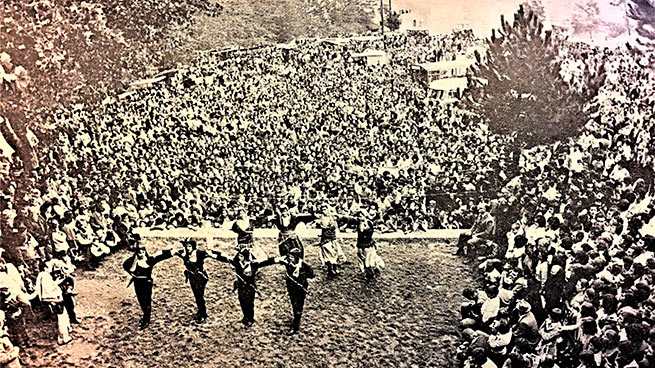
Dance groups of the Pontian associations in front of thousands of pilgrims during the celebration of the Dormition of the Virgin Mary at Panagia Soumela in Trebizond. Photo archive Stefanos Tanimanidis.
Stefanos Tanimanidis, Honorary President of the Panhellenic Federation of Pontian Associations, recalls the day he first stood in front of the Monastery of Panagia Sumela in Trabzon with tears in his eyes. It was in the late 1990s, when he took part in the first organized mission of the faithful who came to the Black Sea to venerate the monument, a symbol of Pontic Hellenism, under the watchful eye of the Turkish police and army.
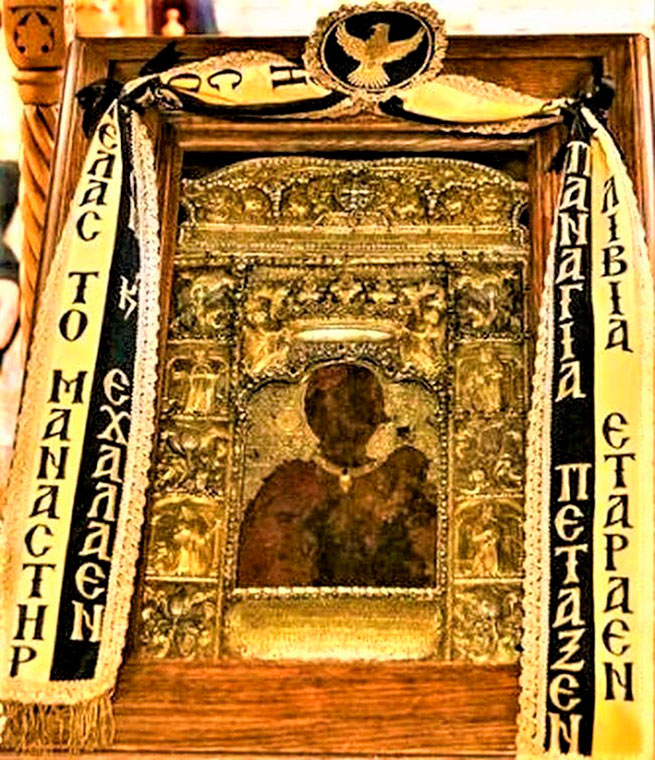
The icon of Panagia Soumela, which according to tradition is the work of the Apostle Luke. Today it is kept in the new monastery of Panagia Soumela in Vermio, Imathia. Photo archive of Stefanos Tanimanidis.
In the following years, new visits awaited us. However, the year 2010, August 15, the day of the celebration of the Dormition of the Mother of God, became significant: Ecumenical Patriarch Bartholomew, with the permission of the Turkish authorities, was to celebrate the first Divine Liturgy in the monastery after 88 years of “silence”.
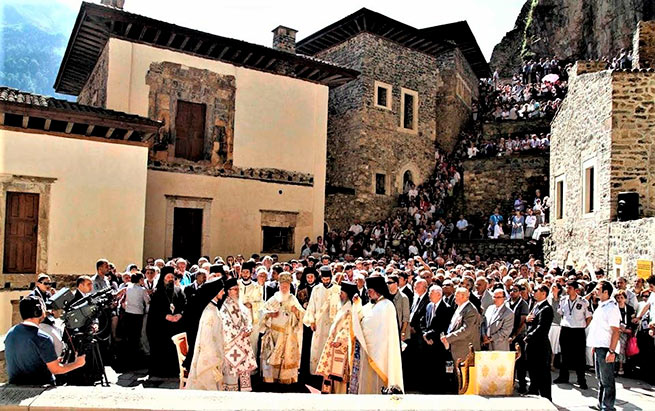
Patriarchal Divine Liturgy at the Monastery of Panagia Soumela. Photo archive of Stefanos Tanimanidis.
Hundreds of believers gathered in the courtyard, thousands watched the liturgy through huge screens installed in the monastery courtyard. Generations of Pontic Greeks were at the foot of Mount Melas that day to see, to know, to learn, so as not to forget. It was a vindication after decades of struggle, which was achieved by the “seal” of the Ecumenical Patriarch Bartholomew.
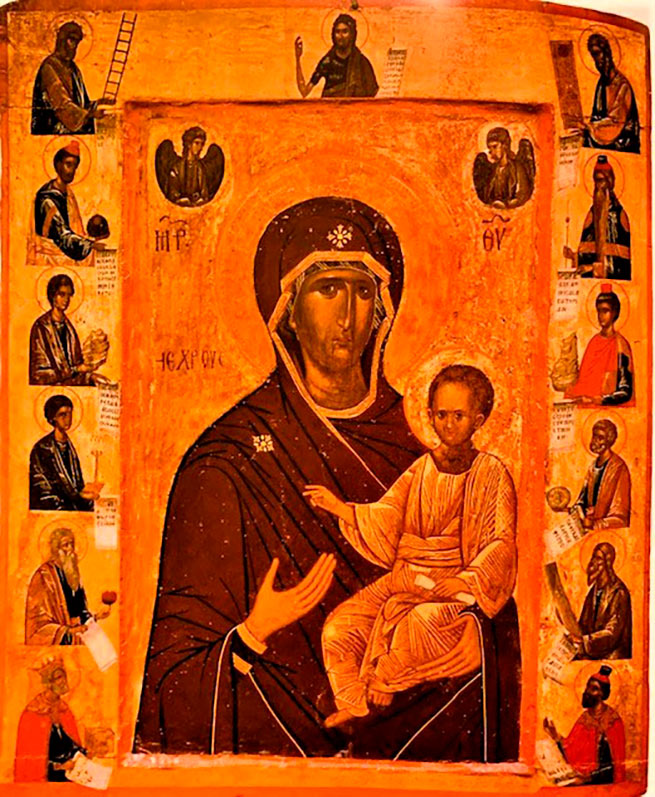
Image of the Virgin Mary, Virgin Child, 13th century, in the National Gallery, Dublin Museum. Stefanos Tanimanidis Photographic Archive.
Stefanos Tanimanidis was there, honoring the history of his family, which has been linked to Panagia Soumela for three generations. “This is the sacred symbol of our religion and our people, which for centuries has been identified with our presence on this land. Our holy pilgrimage sites, where thousands of pilgrims flock every year, are a miniature Pontus. This is our Amphictyony, a spiritual beacon and guardian of our tradition,” – he says.
The historic day of August 15, 2010 marked the beginning of the bells Sumely rang again – in the following years – on the great Christian holiday. In 2015, the monastery was closed for restoration work and the removal of stones that threatened to destroy the monument. In the summer of 2020, the Turkish Ministry of Culture announced the completion of the work and gave permission to open the monastery as a museum for visitors and pilgrims. A year later, the patriarchal mass in honor of the Assumption of the Virgin Mary was celebrated in the monastery again. The same thing happened in 2022. And each time with the same emotional charge for the thousands of pilgrims who camped on Mount Mela the night before, wanting to feel the solemn atmosphere closer to the scene of the events.
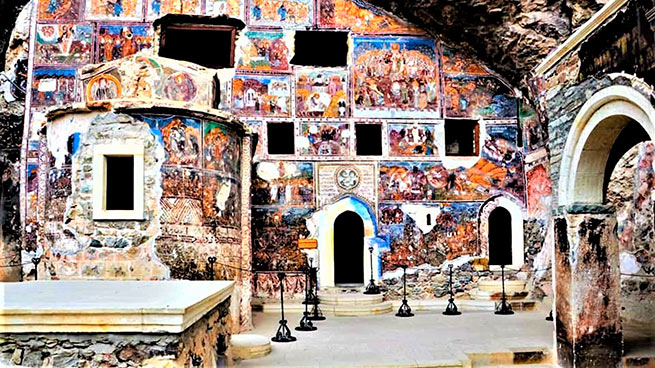
External view of the Catholicos church of the monastery, located in the rock. Photo archive of Stefanos Tanimanidis.
“Panagia Sumela” connects Pontic Hellenism with its original cradle. Until 1922 and for 16 centuries, the monastery of Panagia was a powerful religious, spiritual symbol of Hellenism in Little Pontus. Until 1922, the influence of the monasteries in Pontus was enormous. We had three large monasteries: Panagia of Sumela, John of Vazelon and George of Peristeria. These are ancient monasteries that spread the radiance of Greek Orthodoxy throughout the Black Sea region, Russia, Ukraine, and Crimea. The spirit of Greek Orthodoxy had a huge influence, says Vlasis Agtsidis, PhD in History and Doctor of Modern History.
This year, 13 years after the first patriarchal mass in the historic monastery, there was a stir for the first time. On July 20, the Ecumenical Patriarchate announced that the Turkish authorities had not given the necessary permission to celebrate the Divine Liturgy on August 15. “Recovery” happened four days later, when a message came from the Phanar that permission had been granted and the liturgy would be celebrated as usual. The Turkish authorities quickly changed their minds.
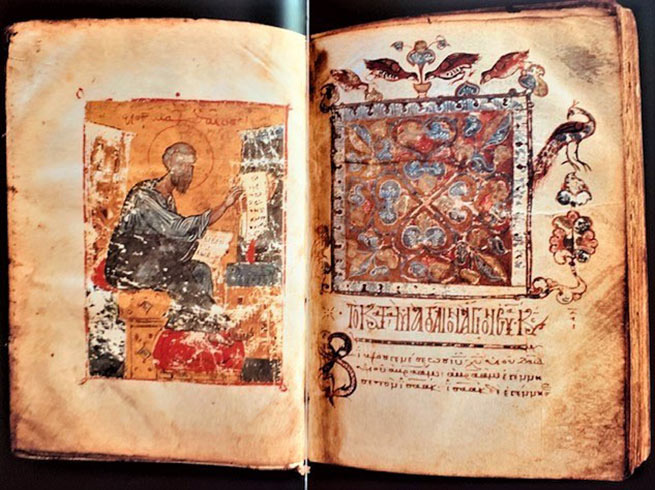
The Fourth Gospel of Panagia Sumela in homographic facsimile. It is located together with about 50 other relics of the old monastery in the storerooms of the Ankara Museum. Photo archive of Stefanos Tanimanidis.
“The refusal of the Ecumenical Patriarchate was caused by the official response of the Turkish Ministry of Culture. Possible reasons are related to the growing Islamist and nationalist trend that has been cultivated in Turkey since the 2016 coup.”– says “K” Agtsidis, explaining the rapid change in the attitude of the Turkish authorities.
“The strong reaction of the Ecumenical Patriarchate, civil organizations – mainly Pontian associations – and the official condemnation of the ban by the Greek Foreign Ministry probably forced the Turkish authorities to reconsider their initial decision. This was certainly facilitated by Turkey's desire to normalize, at least temporarily, Greek-Turkish relations, wishing to avoid actions that could expose it in the eyes of international public opinion.”
“On the day when Turkey's intentions became known, the Panhellenic Federation of Pontian Associations immediately responded to this with a letter to the President of Turkey Tayyip Erdogan – to visit our national-religious symbol, and instead benefit by showing respect for religious freedoms and rights, we expect from you the appropriate initiatives”– says, in particular, the letter signed by the Honorary President of the Federation Stefanos Tanimanidis.
Panagia Sumela – a “beacon” of tourism development for Turkey. However, Turkey's policy towards Greek monuments, both ancient and medieval, has gone through several “waves”. “After 1922, the line was taken on “destruction and concealment” because the monuments preserved the memory of Greece. Thus, all the monasteries of Pontus were abandoned to the mercy of bandits and time, as a result of which a significant part of them were destroyed”– explains Vlasis Agtsidis.
Turkey's policy began to change in the 1980s and even more so in the 1990s. It was during this period that the “flow” of visitors from GreeceThe arrival of thousands of pilgrims resulted in much-needed tourist currency.
“The Turkish authorities realized that these monuments could become”beacons” tourist development of the region and a means of economic prosperity. At the same time, a new generation of more open people has emerged. Thus, the repair of the monastery of Panagia Sumela, whose roof had collapsed and was badly damaged, was included in the UNESCO program. The project was a success,” – says Agtsidis, referring to the permission that is given every year to hold the Divine Liturgy on August 15, an event that attracts thousands of pilgrims from different places to Trabzon.
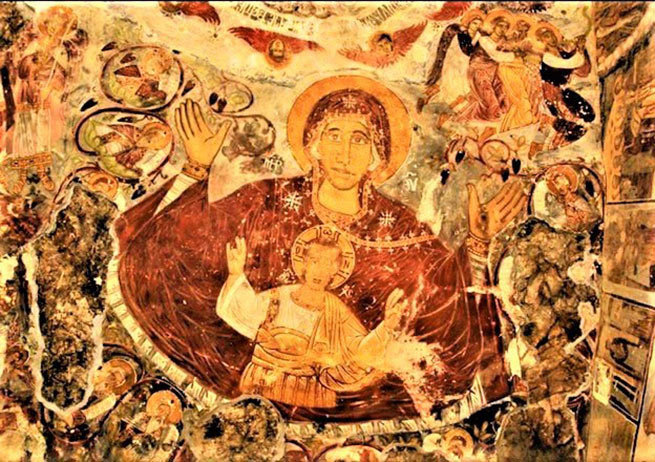
Vandalized frescoes of the monastery's life after their recent restoration. Photo archive of Stefanos Tanimanidis.
The restoration has, however, sparked a backlash, with many believing that the monument's Greek Orthodox identity has been weakened. “Our struggle is aimed at restoring the true identity of Panagia Sumela. The “incorrect” restoration of the monument's architecture may satisfy tourists who no longer see the ruins and ease our own pain, since we do not see the destruction that the monastery has suffered, but its skilful transformation will not make us forget the events committed against us by the Turkish governments of that time and how they destroyed the monastery. No matter how they try to appropriate our culture, our monuments, our dances, this policy cannot be effective, since it shows that it does not respect the right to diversity.”
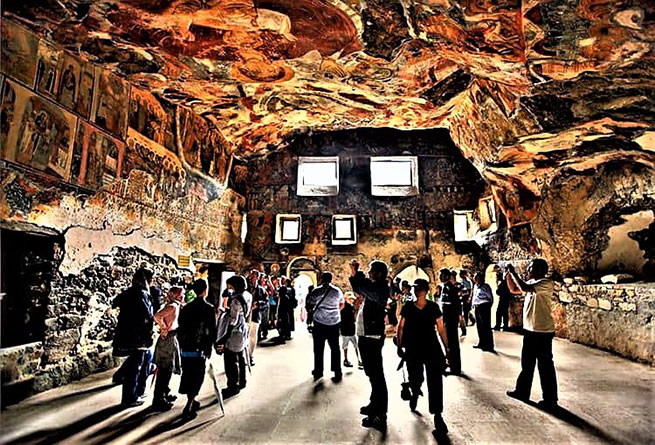
The interior of the monastery after restoration work, which lasted from 2015 to 2020.
However, in the last 15 years, the Panangelan Federation of Pontian Associations has been waging a new struggle: to collect and use all the relics located outside the monastery, which have been kept for decades in the repositories of Hagia Sophia in Istanbul, in museums and private collections, in order to return them to their natural habitat – the monastery of Panagia Sumela in Trebizond.
“This proposal is addressed to the current politicians of Greece and Turkey, and calls on them to follow in the footsteps of Eleftherios Venizelos and Ismet Inonou, at least in this matter, and to help free all these historical relics. They must be taken out of the dark cellars that have remained untouched for decades, and new historians and researchers must be allowed to study them in order to reveal not only their origins, but also new elements of the sixteen-century history of the monastery of Soumela,” concludes Stefanos Tanimanidis.
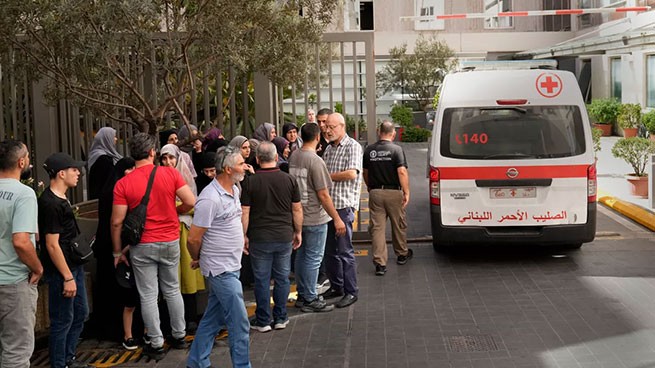

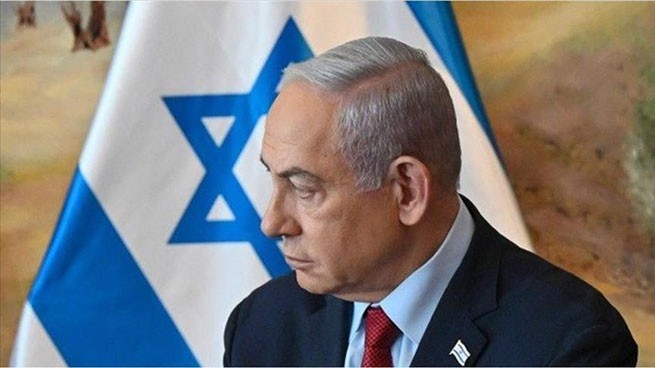

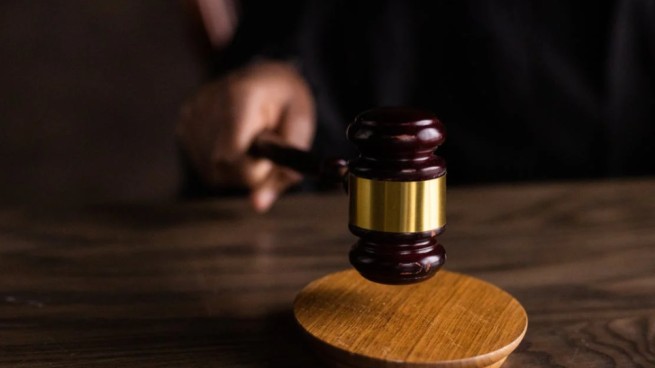
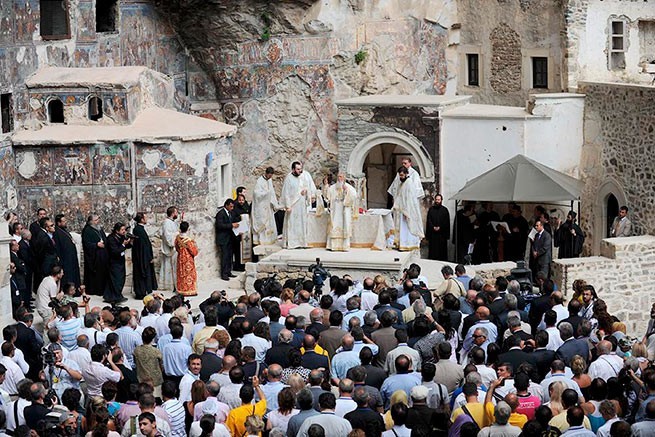

More Stories
The Magic Number 56 and the Covered Market of Kalithea. Part 2
The Magic Number 56 and the Covered Market of Kalithea. Part 1
Istanbul pogrom, September 6-7, 1955